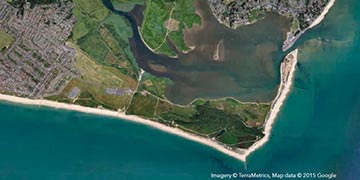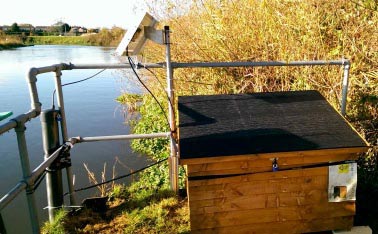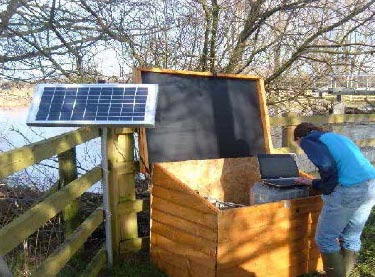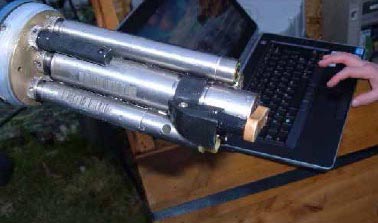Estuary Research Highlights Advantages of Continuous Water Quality Monitoring
Researchers from the south coast of England have established a small network of monitoring instruments in Christchurch Harbour and associated rivers to study the effects of weather events on water quality and to better understand the magnitude and spatial/temporal variation of macronutrient fluxes - nitrogen (N), carbon (C) and phosphorus (P).
The project, which is financed by a Natural Environmental Research Council grant, has involved the installation of three continuous monitoring stations; one in the harbor itself, a second in the River Avon, and a third in the River Stour. Each monitoring station includes a Xylem YSI EXO2 multiparameter water quality monitoring sonde and a Xylem Storm 3 Data Logger that wirelessly transmits the data to a cloud hosted data collection platform so that readings can be viewed on the project website.
With over a year of data, project lead Prof. Duncan Purdie says: “We were fortunate with the storms that took place over the winter of 2013/14, because we were able to gather excellent high-frequency data on nutrient fluxes and water quality during severe weather, which has dramatically improved our understanding of the effect extreme river flows have on nutrient fluxes into the estuary.
The monitoring systems worked very well during this period and we were particularly impressed with the performance of the EXO2 sondes and the Storm loggers.”
Background
Human activities have enhanced global cycles of N (nitrogen) and P (phosphorus) by around 100% and 400% respectively since the industrial revolution, and this is having a major impact on the world’s water resources, resulting in serious detrimental effects on water habitats leading to, algal blooms and eutrophication.
However, our knowledge of macronutrient fluxes through estuaries is limited and estimates are often based on low sampling frequencies leading to large-scale approximations, so there is a need to better understand fluxes of N and P through estuaries and how their behavior is impacted by processes operating over a range of temporal and spatial scales.
In addition to monitoring macronutrient fluxes, the project has investigated the eutrophication status of the estuary with summer reduced river flows leading to longer water residence times resulting in harmful algal blooms, that can cause reduced dissolved oxygen levels which threaten migratory fish, for example. The project has also sought to determine whether high river flows during the winter affect the estuarine benthic habitat and local fisheries.
Historically, most water quality monitoring in rivers and estuaries has taken place at fixed time intervals that are spaced too far apart to capture severe weather events, so there is a heightened demand for instruments that are able to operate unattended for extended periods. This means that they must be robust, resistant to fouling, and able to operate on low levels of power without requiring frequent recalibration. Low power remote telemetry capability also reduces the frequency of site visits and thereby further lowers operational costs.
Monitoring Sites
Christchurch Harbour is a particularly interesting and important water resource. It was chosen for this project because it is a relatively small and constrained estuary with easily accessible sites for monitoring. The estuary has two main rivers (the Stour and Hampshire, Avon) feeding into it, and exchange with coastal waters is provided by a narrow (~45 m) channel at Mudeford.
The two river catchments have similar characteristics; both containing high proportions of chalk in the upper and middle reaches and tertiary sands and gravels in their lower sections. The River Avon is designated as a Natura 2000 site because it supports internationally rare species such as floating water crowfoot and starwort; and fish species such as brook lamprey, migratory salmon, sea lamprey and bullhead. The Hampshire Avon is one of the most important chalk river systems in the UK, with over 180 species of river plant, one of the most diverse fish populations, and a wide range of river invertebrates.

Equipment Deployed on the River Avon

Equipment Deployed on the River Stour
In addition, the river is important for its populations of water vole and otter. All of these species are affected by river quality.
Water Monitoring Challenges
The Environment Agency is already working with local water companies to implement improvements to sewage treatment works that will reduce phosphate levels in the discharges from these plants. However, there is also a requirement to lower macronutrients from other sources (eg farming), so it is convenient that a further project is being conducted in the upper reaches of the Avon, also involving continuous water quality monitoring. Known as the Avon Demonstration Test Catchment project (Avon DTC), this seeks to test the hypothesis that it is possible to cost-effectively reduce the impact of agricultural diffuse water pollution on ecological function while maintaining sustainable food production through the implementation of multiple on-farm mitigation measures. As a result, the knowledge gained from the Avon DTC project will complement that from the Christchurch Harbour Macronutrients Project.
The Christchurch Harbour project is one of four consortium projects funded by the NERC Macronutrient Cycles Programme. The project’s consortium is made up of a team of scientists from the Universities of Southampton, Portsmouth and East Anglia, and the National Oceanography Centre, Southampton. The monitoring equipment was first installed in late 2013 and early 2014, and is due to run for 3.5 years. In conjunction with modeling, the monitoring data will enable the scientists to produce an accurate assessment of the impact of nutrients entering the estuary during short-term storm increased flows in the two rivers.
Data from the study are being used to create a powerful statistical model of the distribution of excess phosphates and nitrates, how they transfer from rivers, through estuaries, and into the coastal seas, and the role that storms play in this process. The team anticipates that this will allow policy makers to make more informed decisions about how to reduce nitrate and phosphate pollution in estuaries.
Continuous Monitoring Equipment
The YSI EXO2 sondes are designed to run on low power for long-term deployments. Each sonde is able to accommodate a large number of sensors and in this project, they included dissolved oxygen, conductivity, temperature, turbidity, chlorophyll, depth, and pH. The EXO sondes contain internal batteries and can be deployed on their own, but in order to provide near real-time data to the ‘Storm Central’ website, they were each connected to a Storm datalogger with a solar-powered battery pack. 
A novel ‘lab on a chip’ nitrate sensor also forms part of the monitoring system. Developed by scientists at the NOC, the nitrate monitor performs miniature colorimetric nitrate analysis at hourly intervals, with a serial output to the Storm datalogger. Consequently the nitrate data has been incorporated with that from the EXO sondes.
The EXO sonde at the Christchurch Harbour pontoon was also fitted with a fDOM sensor (Fluorescent Dissolved Organic Matter) which provides greater insight into water quality; typically displaying an inverse relationship with salinity revealing high DOM levels in the freshwater entering the estuary.
The monitoring system has the ability to output alarms when pre-set conditions occur, including relationships between different sensors. Alarms can trigger emails, and text messages are also possible with minor additional equipment, however, the alarm function was not enabled for this project. Automatic water samplers were also employed by the project, taking samples at pre-set intervals, but if necessary the samplers could be set to initiate sample collection when certain conditions occur, such as a lowering of river conductivity caused by a surge of freshwater.

Additional Blog Posts of Interest
Sea Level Rise Research: Clam Bayou Estuary Florida
Extend Your Water Quality Sonde Deployment Times with Wiped Sensors [Case Study]
Integrating Watershed Based Activities with Coral Reef Ecosystem Management
Southeastern Estuarine Research Society Meeting fDOM Sensor Research